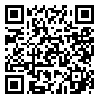BibTeX | RIS | EndNote | Medlars | ProCite | Reference Manager | RefWorks
Send citation to:
URL: http://jdisabilstud.org/article-1-2809-en.html
2- PhD student in Psychology, Department of Psychology, Science and Arts University, Yazd, Iran
3- Assistant Professor, Department of Psychology, Science and Arts University, Yazd, Iran
Abstract
Background & Objectives: Adolescence is the most appropriate period for personality formation in developmental psychology. One of the effective factors in the emergence of self–injury behaviors is the Ego. It refers to the second personality structure in Freud's theory, created by the forces in the Id. Ego functions include communication with reality, regulation, and control of instinctual forces, object relations, thought processing, defense functions, and combination and judgment functions. Another effective factor in self–injury behavior is personality. It is roughly the unique style of a human being in matching with the environment, which is somewhat different from other people's styles. By examining the Ego variable and clinical personality patterns, it is possible to identify teenagers prone to self–harm behaviors and prevent them by appropriate psychological interventions. Therefore, this research aims to predict self–harm behavior based on the sense of Ego strength and clinical personality patterns in adolescents with self–harm disorder.
Methods: The method of the present study was descriptive–correlational according to the nature of the study subject and the intended objectives. The study population comprised all adolescents living in Yazd City, Iran, in 2021. The participants were selected by available sampling, and the sample size was calculated as 100. In this research, according to the study topic, the required information about the theoretical foundations of the variables has been collected using the library and field methods. The inclusion criteria were as follows: the subject was between 14 and 18 years old, motivated to enter the research, and had a history of self–injury. The exclusion criterion was not completing the questionnaires. The study data were collected via the Inventory of Statements about Self–injury (ISAS) (Klonsky & Glenn, 2009), Psychosocial Inventory Ego Strengths (Markstrom et al., 1997), and Millon Clinical Multiaxial Inventory–III (MCMI–III) (Millon, 1994). To analyze the data at the level of descriptive statistics, mean and standard deviation, and at the level of inferential statistics, the Pearson correlation coefficient and multiple regression analysis were used in SPSS version 24. The significance level of the tests was set at 0.05.
Results: Strong sense of Ego could predict self–injury behavior (p=0.002, β=0.226). Also, personalities of schizoid (p=0.001, β=0.310), avoidant (p=0.011, β=0.655), depressed (p<0.001, β=0.572), dependent (p=0.031, β=0.154), dramatic (p=0.042, β=0.426), narcissistic (p=0.022, β=0.614), antisocial (p=0.002, β=0.431), negativity (p=0.010, β=0.423), other harassment (p=0.005, β=0.218), self–harm (p<0.001, β=0.648), obsessive (p=0.038, β=0.129), paranoid (p=0.024, β=0.408), and borderline (p<0.001, β=0.519) could predict self–injury behaviors in adolescents.
Conclusion: According to the research findings on the predictive role of clinical personality patterns and the strong sense of Ego in the self–harm behavior of adolescents, we recommend that experts pay attention to these issues to prevent and treat self–harm behavior in adolescents.
| Rights and permissions | |
 |
This work is licensed under a Creative Commons Attribution-NonCommercial 4.0 International License. |



